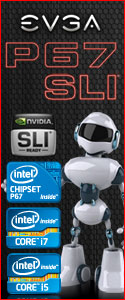As you probably gathered from the previous pages, the Synapse Cache SSD comes in a 128Gb and 64Gb model. Today we will be testing the 64Gb version of this hardware. We will be using a EVGA P67 FTW motherboard that has SATA 6 Gb/s through the Intel P67 PCH. We will be using a Western Digital Black 1.0TB SATA 6 Gb/s 64MB cache HDD to pair up with the Synapse SSD.
In order to get a good feel for the speed increase the Synapse provides, we will need to test the speed of the Western Digital HDD first as a stand alone system drive. Once that is complete we will test the raw speeds of the SSD drive by itself, and finally we will test the speeds after both drives are combined and the Synapse is doing the caching for the Wester Digital HDD.
We will NOT be comparing the Synapse Cache SSD’s raw speed against other SSD’s that are intended to be used as the main system drive, as this is not what the Synapse is intended for. The Synapse Cache SSD is advertised as, enhanced for, and sold with the intent of raising the performance level of a system that uses a traditional platter type HDD for the system drive. Therefore, what we are interested in is how well the Synapse Cache SSD does what OCZ says it can do. It goes without saying that the raw performance numbers of a SSD cache drive will never equal that of a SSD intended for use as a main drive, they are two different animals.
The western Digital hard drive we will be using for testing will be loaded with Windows 7 and several other popular applications so we can get a feel for “Real World” performance levels. It doesn’t make much sense to run benchmarks on drives that have stripped down installations just for the sake of a higher benchmark scores, after all who uses a computer for day to day work with nothing on it?
Before we begin the testing it might be a good idea to go over the Dataplex software and how to prepare the Synapse Cache for installation. OCZ has a terrific video on the whole process, we strongly urge you to watch it before attempting to use the Synapse Cache SSD. Keep in mind that the Dataplex software will only work with Windows 7.
As you can see by the video above, the software is easy to install and the whole process of installation takes very little time to complete. Once the Dataplex software has been installed and your computer rebooted, you can easily check the status of the Synapse Cache. All and all a painless operation!
Alright, it’s time to get started with the testing! We ran each bench mark on the Western Digital as a stand alone drive, the OCZ Synapse as a stand alone drive, and finally the two combined with the Synapse doing the caching. You will be able to compare the results to see the performance gain the Synapse Cache provides. The testing on the Synapse as a stand alone drive is intended to give you an idea of the raw performance level it provides. Each test was run three times in order to give the Synapse Cache SSD an opportunity to cache the benchmarks.
HD Tach
|
|
|
|
|
|
HD Tune
ATTO
Crystal Disk Mark
AS SSD
It’s easy to see by the results above that the caching function works quite well and really shows some good testing numbers. If you compare the Western Digital standalone tests to the Caching test you can see the huge speed increase.. From the minute we installed the software we could notice an increase in performance. After a few system restarts the boot time was greatly reduced as well.

















 Posted in
Posted in 





